It’s unfair to restrict the quality of a ship to a unique characteristic, so to summarize, but four points could help cornering her a little bit.
- Russian built
- Lightly armed
- Oil-burning boilers (world’s first)
- Slow completion and overweight
She was the result of discussions in the admiralty and changes of directions; but reflected also the state of industrial expertise of a young shipbuilding industry with teething problems. Rostislav was envisioned as the head of a possible serie of coastal battleships to defend Sevastopol in 1890, possibly to be used also in the Pacific. Short range and light displacement, but 12-in guns and seaworthy enough for black sea operations were its main initial characteristics. She was named after Rostislav I of Kiev, famous medieval Prince of Smolensk and Novgorod, at the head of the Kievan Rus.
Although the ship and its powerplant were of fine quality, there were issues with her Russian-made guns Obukhov guns, and their mounts that delayed considerably her completion. The rest of the Artillery was French, as well as the turret design, and the armour was American, using the new Harvey process. Her belt protection was doomed by overweight issues, which were never really resolved. After Tsushima, the Black sea fleet starved for funds that would be necessary to modernize her and solved her protection problems. They stayed an issue all along WW1, as well as her relatively weak main armament, compensated by progresses made in long range gunnery accuracy (new fire control, rangefinders and ballistic tables).
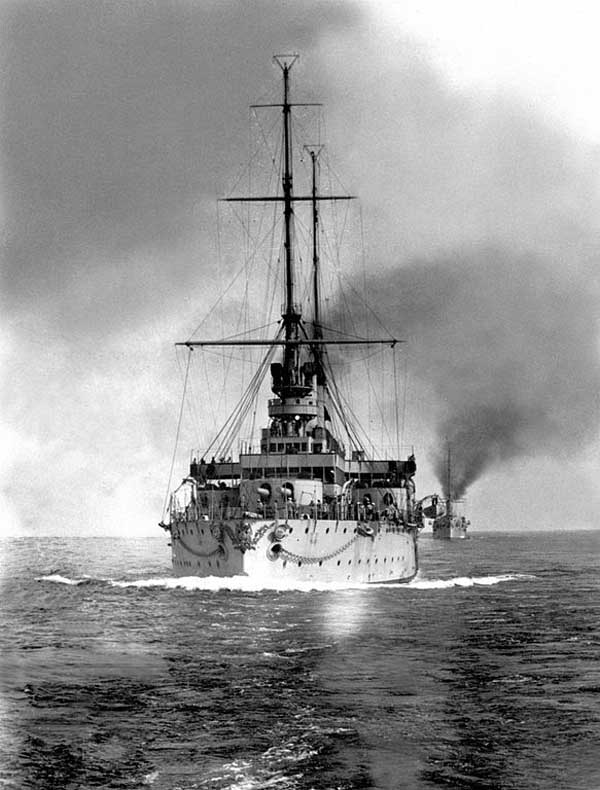
Rostislav underway in the black sea, circa 1905-1906
Development of the design
The battleship Rostislav was the brainchild of Admiral Nikolay Chikhachov, at the head of the Ministry of the Navy. He envisioned in 1892 a squadron 4,000-5,000 “pocket battleships” to fit in a 24,000 long tons targeted total displacement for the black sea fleet. Chief designer of the Nikolaev Shipyard, Sergey Ratnik, was consulted in mid-1892 on this proposal, but quickly advised against it. His position was compounded by the Naval Technical Committee (NTC). They estimated also that combining firepower, protection, speed and stability in such a small package was unrealistic, and only at least 6,000 long tons (6,100 t) of displacement was a base to go further.
In response, Ratnik’s advised to just build a modernized and more compact version of the Sissoi Veliky which displaced 8,880 long tons. But he remained firm in his initial proposal, soon rejected by the NTC, which further declined to discuss tactical matters. Chikhachov was left free to decide the armament. This back-and forth process took the better of 1892 and early 1893.
Eventually, Andrey Toropov, at the head of Nikolaev Shipyard was ordered to design two proposals at the request of Chikhachov, which wanted a confirmation: one with 10-inch and one with 12-inch guns to see of they were realistic. Toropov estimated the displacement needed in both case to be at least 8,880 tons. Admiral Chikhachov eventually had to admit this as fact and transmitted the designs to the NTC. Both Chikhachov and the admiral’s board agreed on the 12-inch variant, as being already a world’s standard.
The NTC, consulted, however advised against it. The Navy brass further discussed the issue April-May 1893 and eventually settled on a larger displacement of 8,880 tons, but stand firm on the 12-inch guns. Eventually, the CNT apparently went over their head, and General Admiral Grand Duke Alexey put an end to the debate on forcing the adoption of the smaller caliber variant.
To speed up the design process it was accepted to take the same hull as Sissoi Veliky, but protected with the newly developed Harvey armor and a serie of grounbreaking innovations, such as the use electric power instead of hydraulic power, and oil-burning boilers. The definitive designed was sanctioned and accepted in late 1893. The ship was voted at the Duma and the order came in December 1893, to Nikolayev Shipyards. Rostislav was laid down on 30 January 1894.
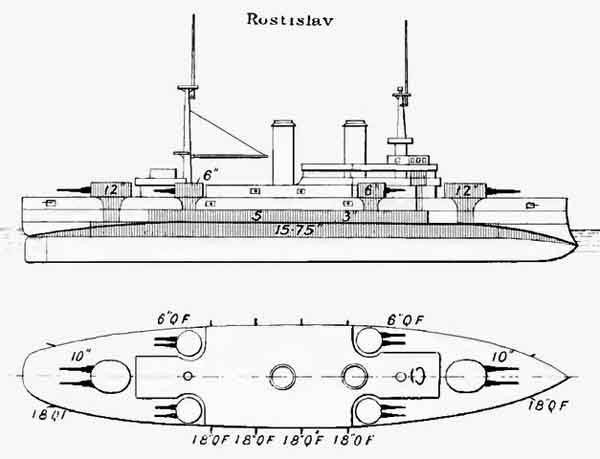
Brassey’s diagram of Rostislav
Design
Rostislav measured 105.3 m long (345 feet 6 inches) at the waterline, 107.2 m overall (351 feet 10 inches) for a beam of 20.7 m (68 ft) which made a 1/5 ratio, and 7.7 m (25 feet 2 inches) in draught. The final displacement figure as built was 10,520 long tons (10,690 t) standard. It was 1,500 long tons more than initial designed displacement (8,880 long tons). This was notably the result of bad calculation over the waterline armored belt total weight and other additions.
Modifications during construction
Rostislav’s preliminary work started on January 30, 1894 but she was officially christened on May 20, 1894 as the formal laying down ceremony took place almost one year after on 19 May 1895. Baltic Works was in charge of forging an providing the powerplant, oil-firing boilers and VTE engines. Since the brand new Harvey process was chosen for the armor, plates were ordered in the United States, at Bethlehem Steel. They were part of the same contract to provide its armor to the Petropavlovsk-class battleships, the first protected with it in the Russian Navy. Bethlehem Steel however was the object of an enquiry of the Senate Committee on Naval Affairs for an alleged price per ton half ws it was paid by the US Navy, a prejudice to US taxpayers.
The hull was launched on September 2, 1896 and due to the absence of cranes later, Nikolaev’s Yard had to creative improvize ways to install its massive engines in place. This became so difficult, that the prospect of completing the ship to Sevastopol was contemplated. In July 1897, fitting out almost over (less the armament) and the ship could sail already. The new Russian battleships made her speed trials on October 21, 1898 showing her power plant did the job, but the problem laid with engineers calculation over the combined hull and armor weight, with a surplus of 295 long tons which impacted performances and changed the waterline.
The problem rapidly came on the armament side, as the 10-inch Model 1897 guns chosen were manufactured by Obukhov in Saint Petersburg. In addition, the factory had to provide the Admiral Ushakov-class and Peresvet-class and was not familiarized with many complex techniques. This alone delayed the completion of Rostislav until late 1899. Indeed on fire trials, a gun ordered for Admiral Ushakov exploded at the proving ground. Further tests were made, showing many defects and poor control quality in general. Many tubes were refused and had to be manufactured again.
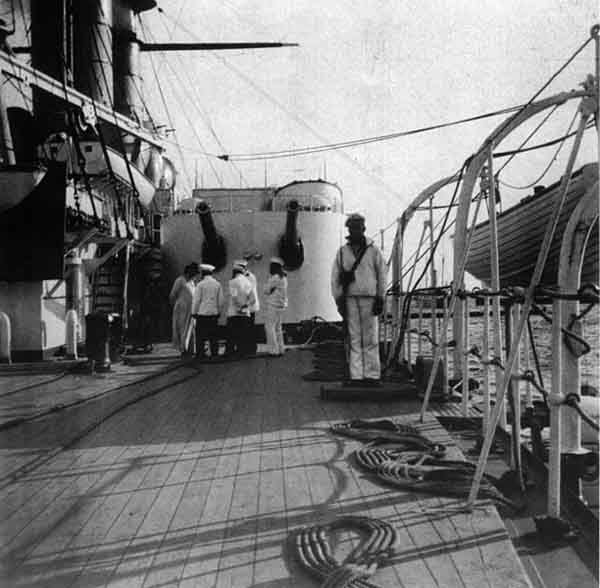
Secondary turrets on Rostislav
Ultimately Guns 16-19, the four intended for Rostislav, completed their tests successfully and were shipped to Sevastopol in the summer of 1899. They were installed in the turrets, and Rostislav performed her first gunnery trial on April 12, 1900, with all her armament in place. Secondary and light guns were standard and arrived sooner indeed. The trials showed recoil mechanisms and the cradle base had many manufacturing defects.
Turrets were retired, mounts deposed and repaired, but not changed, so the problem persisted, to the point no further live firing tests were made, the guns never fired until 1901, when they were rebuilt like those used by the armored cruiser Admiral Nakhimov. In June 1902 Rostislav passed her final gunnery tests. At last, the electrical power that drove the turrets notably proved complex to maintain and troublesome with their 332 contact pairs.
Powerplant
Rostislav had two shafts propellers connected to two standard vertical triple-expansion steam engines. They were identical to those onboard Sissoi Veliky. Total output was 8,500 indicated horsepower (ihp), or 6,300 kW. Steam came from eight cylindrical fire-tube boilers. The great novelty however, was to introduce alongside four coal-fired boilers, four oil-fired boilers. This made Rostislav in effect the first capital ship worldwide to use fuel oil. The main reason, contrary for example to the British Empire, was due to immediate cheap oil from Baku, way cheaper and better for energy independence that importing coal at great cost.
Rostislav performed her sea trials in 1898, her powerplant delivering 8,816 ihp (6,574 kW) for a top speed of 15.8 knots (29.3 km/h; 18.2 mph). Total carried was 820 long tons (830 t) of both fuel oil and coal. This allowed a range of 3,100 nautical miles (5,700 km; 3,600 mi) at 8 knots (15 km/h; 9.2 mph).
Protection
As said above, Rostislav was fitted with Harvey Armor, a new process to harden steel which has to do with a long cooling process, injecting carbon to obtain the best hardened surface, but essentially a sandwich of a very hard, brittle high-carbon steel on the surface backed by a flexible “mattress” of low-carbon wrought iron plate. In the late 1890s, it was made obsolete by the Krupp process.
At the waterline belt the armor plating was 14.5 inches (368 mm) thick, tapered to 10 inches (254 mm) abreast the magazines, with an immune zone covering 227 feet (69.2 m) in length. The belt was 7 feet (2.1 m) high. but the great problem with calculation errors were that much of this belt ended under the water level, and in fact a new waterline was painted above it due to a draft 3 feet (0.9 m) deeper. The armored box was close by a 9-inch (229 mm) bulkhead forward and 5-inch (127 mm) aft. There was an upper belt 5 inches thick, 7 feet 6 inches (2.3 m) high over 160 feet (48.8 m) long.
The main gun turrets had 10 in (254 mm) thick walls, 2.5-inch (64 mm) roofs. The 6-in turrets were protected by equivalent thickness walls as well as the conning tower, unusually “weak”. The flat armor deck was 2 inches (51 mm) thick. There was another layed under the armored citadel, 3-inch (76 mm) thick.
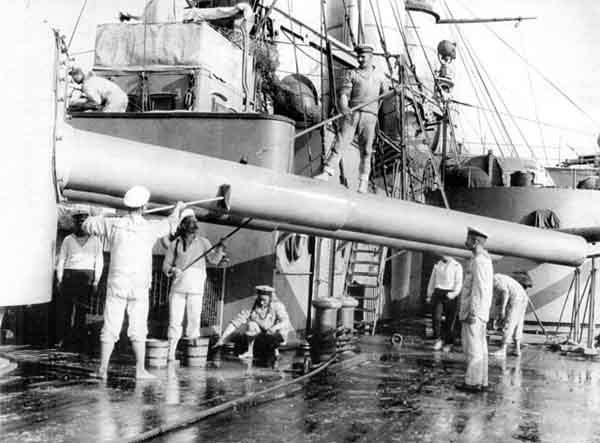
Cleaning of the main turrets 10-in gun barrels
Armament
Main guns:
It consisted in four 10-inch (254 mm) 45-caliber, Model 1891 Obukhov guns. They were mounted in the French-style, in center-pivot twin gun turrets. Each of these, fore and aft, had a 240° arc of fire, maximum elevation of +15° and depression of −5°. Their ammunition was the standard AP shell 496.5-pound (225.2 kg), fired at a muzzle velocity of 2,273 ft/s (693 m/s). Practical max range was 7,320 metres (8,010 yd).
Secondary guns:
The secondary guns were delivered much sooner, from France. These were eight 6-inch (152 mm)/45 Canet Pattern 1891 models, installed in pivot-mounted turrets, six in all on the main deck. They were positioned at corners of the superstructure. Their arc of fire was reduced to 110°. Standard ammunition weighted 91.4 lb (41.46 kg) and had a muzzle velocity of 2,600 ft/s (792 m/s), max range at 20° was 12,602 yards (11,523 m).
Tertiary guns:
To deal with torpedo boats, twelve 47 mm (1.9 in) Hotchkiss guns were mounted on the superstructure (8) and the remainder in the hull, and/or dismounted to be carried by boats and provide close support to landing parties. Their shell weight 2.2-pound (1.00 kg) with a muzzle velocity of 1,400 ft/s (430 m/s). In additions, sixteen 37 mm (1.5 in) Hotchkiss guns were also placed in the superstructure including half in the fighting top. Their shell weighted 1.1-pound (0.50 kg) and muzzle velocity was 2,150 ft/s (660 m/s).
The armament was completed by six 15-inch (381 mm) fixed torpedo tubes, a bow and stern above water tubes a broadside aft pair above water while the forward pair was underwater. In addition, the battleship carried 50 small to surround her anchorage, plus protective nets.
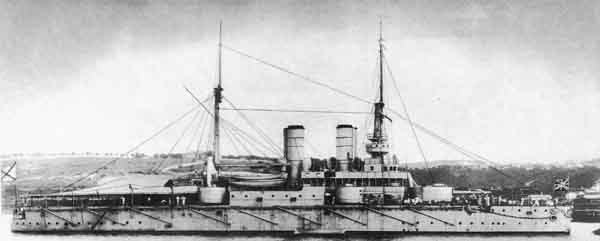
Rostislav in the early 1900s.
Modernization of Rostislav
In 1901 already, the ship underwent a refit: Their main turret being deposed and new overhauled mounts installed which solved their manufacturing issues.
Rostislav was seen as a Royalty’s warship and she was considered a priority customer by the Yards and their contractors. Aside her reconversion to coal-only, the new commander Grand Duke Alexander previously in command of Sissoi Veliky persuaded the NTC to reinforce Rostislav’s rudder frame. He also ordered the installation of a backup control post, well protected, deep under the conning tower to serve this same rudder.
In 1907, the Naval General Staff proposed a major reconstruction of the ship, aimed at solving the main problem: Her excessive draft which made her armor too low to be effective. Indeed a shell would well have pierced through above the citadel and provoke excessive water flooding.
These were radical weight-saving measures: It was decided to remove the above-water torpedo tubes and torpedo nets, auxiliary boilers, 47 mm guns, while the superstructure was cut down, fighting tops (and their 37 mm guns) with a simple pole mast rigging installed in their place. Total displacement of Rostislav could fell by 250 long tons (250 t), but the budget was not here to proceed. Only the above-water torpedo tubes were removed.
In 1912 the Black Sea Fleet command wanted to remove the auxiliary boilers of the Russian Battleship and submerged torpedo tubes only, but also to modernize the main artillery by replacing 47 mm by modern 75 mm guns. but cost considerations again prevented it. Alterations did proceed however, notably most of the 37 mm guns has been removed since 1906, and the next years, modern british-built 15-foot (4.6 m) Barr & Stoud rangefinders were installed, greatly improving long range gunnery. This was just after the disaster at Tsushima, and the year after, Rostislav’s ballistic tables were changed (see later).
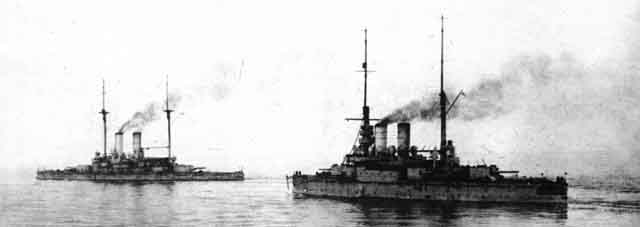
Rostislav and Tri Svititelia in fleet exercises
The Rostislav in action
Captain Grand Duke Alexander Mikhailovich took command of Rostislav on the 1st of May 1899, a member of the Romanov family and only one to do so since Peter the Great. He would also host Grand Duke Kirill several months next year 1900 for exercises in the black sea. Numerous prestigious guests, parties and diplomatic visits however interfered with normal routine of the crew. However all alterations were controlled and expanses paid until 1903, as Alexander was promoted to rear admiral, becoming squadron commander, Rostislav bearing his mark and also be used as the junior flagship of the Black Sea Fleet until 1912.
There were problems however with the guns mountings but also the boilers. Oil burning as it was discovered generated a thicker, darker smoke, making the ship even more conspicuous than using coal. Heat distribution inside the boilers caused local overheating, metal buckling and backdrafts and the boilers gradually ceased to work, from the small auxiliary power unit to the main boilers.
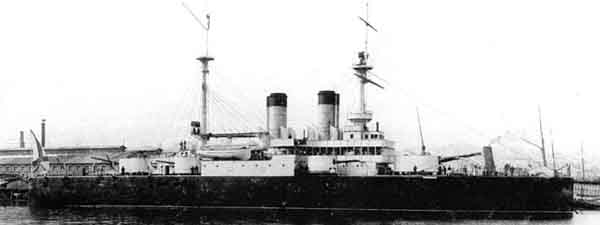
Rostislav was not alone in this case. Other oil-fired ships of the Baltic Fleet had similar issues and this imposed repairs and alterations which culminated in 1904 as the admiralty thrown the sponge and decided to convert the Russian battleship to coal-burning only in 1904-1905. However in addition of these repairs and alterations the ship took more weight, to the point eventually by 1907 its belt armor was entirely underwater.
1905 Mutiny
The severe defeat at Tsushima not only gravely dented the prestige of the Navy and its officers, but the admiralty and the Royalty as well. popular resentment, combined with famine, led to popular revolts brutally supressed by the Tsar’s mounted police. This was known by the crews.
In June 25, 1905, the mutineer group called “Tsentralka” decided to start on Potemkin rather than Rostislav. In consequence two days later when it erupted Rostislav was conveniently at sea under command of Vice Admiral Alexander Krieger.
Nicholas II ordered Krieger and fleet commander Grigory Chukhnin back to Sevastopol, with orders to apply force if necessary one the rebels. After arrival however, the admirals restrained to fire, not to provoke a response which would escalade in a deadly short range artillery duel. Guns were trained on the Potemkine at all times.
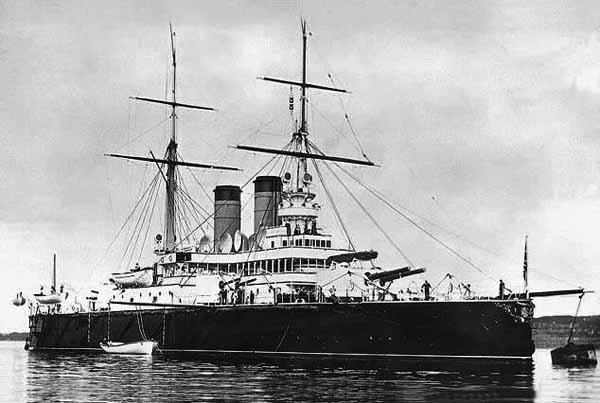
The same officers even left the mutineers fleeing to Odessa unmolested, and Romania afterwards. Krieger indeed knew his own crew on the verge of mutiny too. On July 2, 1905, a military council made it on board of Rostislav to decide how to do. It was decided to moor the ships in Odessa, disconnect propellers shafts and let sailors going ashore. This did not prevented the Ochakov mutiny of November 1905, but fleet morale in between improved, the grip on the crew (with more loyal and trusted sailors) decided Krieger to fire 17 shells against the rebels to put an end to their attempt. Soon after all mutiny prospect in the black sea fleet ceased, to erupt again in 1917.
Post-Tsushima period
In 1908 lessons of the Russo-Japanese war just started to be digested. Alexei Krylov and Yevgeny Berkalov commanded the Rostislav a long-range gunnery shooting, 330 shots made at 8 to 10 miles (13 to 16 km), which proved the original ballistic tables were inaccurate. Data was compiled to help making brand new ballistic, later generalized adopted by the Navy and well as a rapid counter-flooding standard next year, complementary to the old Makaroff device.
This long period saw the black sea fleet, the last homonegeous naval force left in Imperial Russia from the epic disaster of the Russo-Japanese war, absorbing lessons and integrating them in numerous exercises.
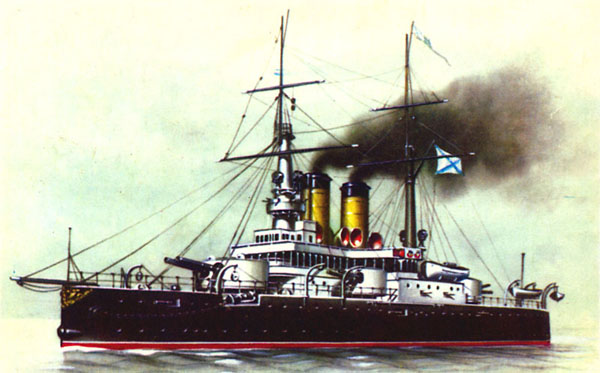
1905-1912 fleet exercises
Improving gunnery skills and fire-control practices became a priority for the general staff. The 1908 long range gunnery exercise led to devise brand new ballistic tables, installed in 1909 and complemented by Barr and Stroud telemeters. Other modernisation plans took place, but budgetary limitations severely limited them. The most crucial problem remained all along: The belt armour was underwater, meaning in case of a duel, round would penetrate the area above, and this openings cause severe water flood.
In 1909-1910, the Black Sea Fleet started joint operations with submarines. At first it was planned to install the first Russian underwater acoustic communication system on Rostislav but it was suspended and later went to the Panteleimon instead. This anti-submarine exercise prolongated into the night of June 11, 1909, and Rostislav accidentally rammed the submarine Kambala, which sank with all hands. Even the two rescue divers trying to recover survivors died in their attempt. The blame fell on the submarine commander while Rostislav’s captain was cleared of any charge by the enquiry commission.
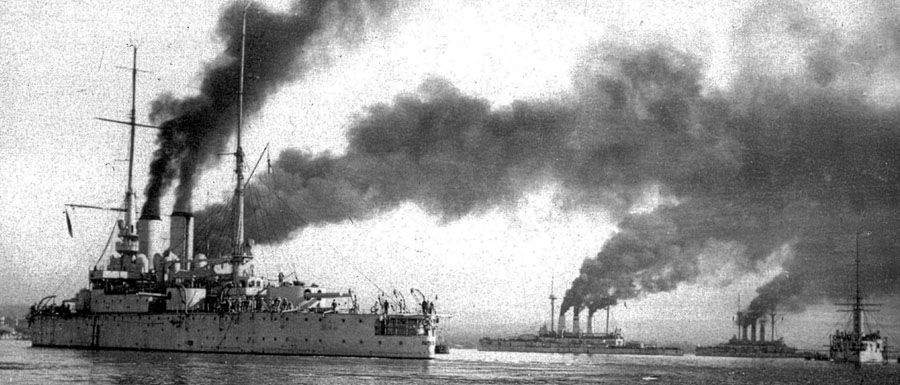
Rostislav was paying a state visit to Romanian on August 11, 1911 with Evstafi and Panteleimon, when she ran aground on a shoal off the port of Constanța. Officers of the battleship detected the obstacle and steered to safety, but failed to alert the other ships, causing the Panteleimon’s demise. This caused an international embarrassment, leading to ehe resignation of fleet commander Admiral Ivan Bostrem.
Another international incident was nearly avoided in 1912. During the the First Balkan War saw Rostislav into the Sea of Marmara, protecting the Russian Embassy in Istanbul. She accidentally fired a live shell into Turkish troops. Fortunately, no one was injured and the captain defused the crisis by making official apologies to the Ottoman government.
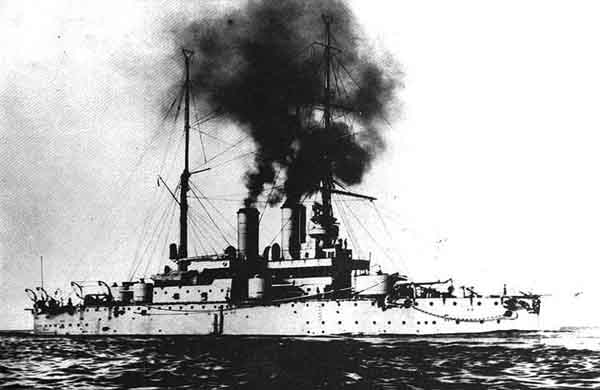
Rostislav in World war one
During the winter of 1913–14 Rostislav was being refitted. In April 1914 she emerged from the yard and returned to active service with a brand new machinery, modern rangefinders, new gun sights, and a modernized armament. She was able to reach 15.37 knots (28.47 km/h; 17.69 mph) on her first sea trials.
By November 1914, the Black Sea Fleet sailed in force to shell Zonguldak. It was a retaliatory attack after the Turkish-German attack on Sevastopol (with Yavuz and Midilli). Rostislav’s captain by then was Kazimierz Porębski. She was the ship chosen to shell the installations whereas the other battleships and smaller vessels made a protection screen around her.
She would fire 251 shells on the port, destroying it entirely. On November 18, she was operating a move after another such attack and crossed the path of battlecruiser Yavuz. This was the Battle of Cape Sarych. However the much faster ships were already out of range when the tail battleship, Rostislav, was able to spot her. She would cross the same ship again in 1915 and 1916, but never duelled directly wit her. In 1915 however, Rostislav was hit by four 75 mm rounds during one such engagement with other vessels.
The Imperatritsa Mariya-class dreadnoughts commissioning robbed Rostislav to any sinificant role as a first line capital ship. She was separated into an independent combat group, as flagship. This Batumi Group was ordered to cover ground operations of the Caucasus Army. Her first sortie in this role was on February 5, 1916, off Arhavi. She fired 400 shells against Turkish positions. On March 4, she and the gunboats Kubanetz and Donetz supported an amphibious landing at Atina. She also supported landings of marines which captured Rize. By late March, helped by Panteleimon she pushed the Turks out of Trabzon.
The summer 1916 admiralty plan was to consider a large scale amphibious assault on the Bosphorus, mirroring the failed Dardanelles operation. Fleet commander Andrei Eberhardt took charge of the project and quickly dismissed any attempts to do so before cleaning up the waters of naval mine. He also stressed the possibility of torpedo boats attacks in coastal waters. He argued as a preliminary for the operations with have the precious battleships in drydock refitted with anti-torpedo bulges.
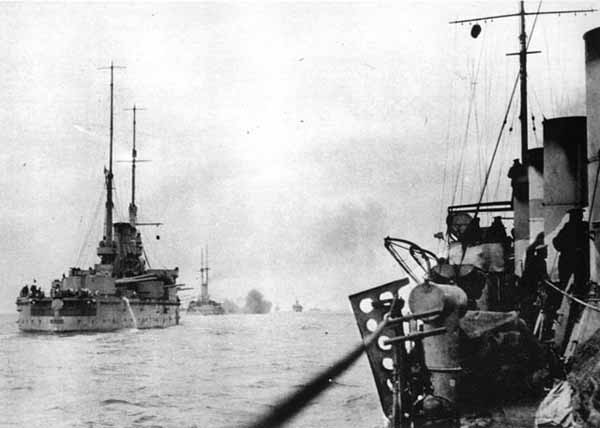
This started with Sinop in Nikolaev in July 1916, and Rostislav was planned to be next when the whole operation was cancelled in August 1916. Rostislav was sent to the Romanian coast as flagship of the Constanța Group. This port became a temporarily huge logistical hub for Russian troops as they operated on the Romanian Front. It was also a base for minelayers, submarines and destroyers which rampaged the Bosphorus area.
The Germans made several air raids on the Romanian harbor, but met little success. They scored however a bomb hit on Rostislav. It blew up on the edge of the aft 10-inch turret, injuring sixteen, but turret remained fully operational. In October 1916, the Romanian Front collapsed and Russian troops were retiring to Constanța. The evacuation commenced immediately. Rostislav took troops with her on her way back to Sevastopol, where she was to be overhauled. She was still in drydock when caught by an event of major proportion in 1917.
Rostislav and the revolution
In February 1917, the Revolution had its effect on the Black Sea Fleet but not as sudden as in the Baltic Fleet. Captain Fyodor Stark maintained Rostislav combat-ready and well-maintained and disciplined until the end of 1917. Elements such as radicals, as well as anti-German feelings and Ukrainisation were kept a bay. She made a sortie to to Batumi in October. However at her retun the crew raised the Ukrainian flag when entering Sevastopol on 25 October.
Later, part of the crew never returned to the ship, and volunteered into the Red Guards. In December 21, this was such that only 460 re-enlisted, plus 28 officers, but in January 1918 this was total collapsed as crew rebelled for good, hunting officers and abandoning the ships and the German Army advanced. By late April 1918, the Bolsheviks captured, manned and sailed two battleships and sixteen destroyers to Novorossiysk, but Rostislav remained.
Sevastopol was captured and occupatied by the Germans untuil November 1918, succeeded after the armistice by Anglo-French forces, which stayed until April 1919. As the “reds” were coming back, it was decided to sabotage Rostislav’s engines. Baron Wrangel instead later captured the ship and used it as a floating battery, towed in the Sea of Azov. She was manned y a small white Russian volunteer crew. Rostislav was anchored in the Kerch Strait, shalling positions in the Taman peninsula, and ensure no landings would take place in Crimea. Wrangel’s whites were eventually defeated, and the small ragtag crew scuttled Rostislav, right in the Kerch Strait to block ships and prevent them to access to the Black Sea.
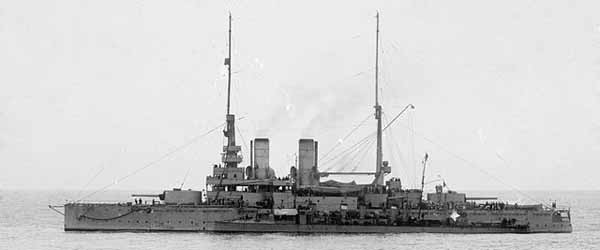
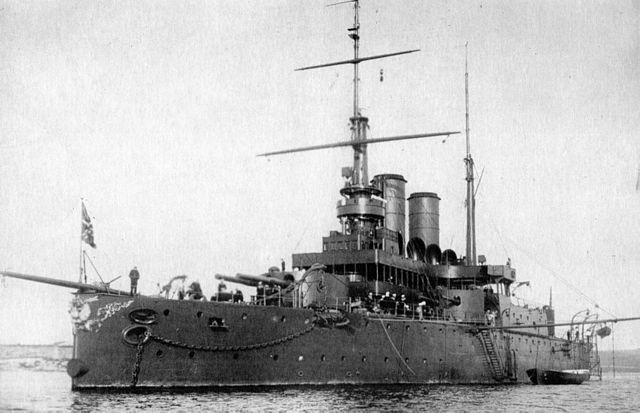
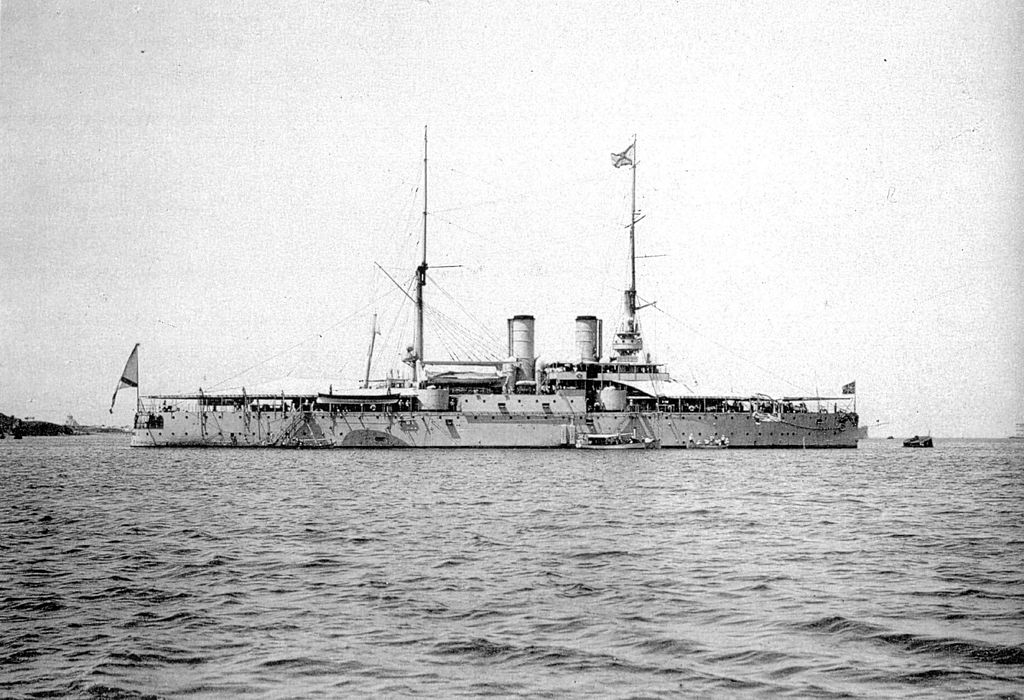
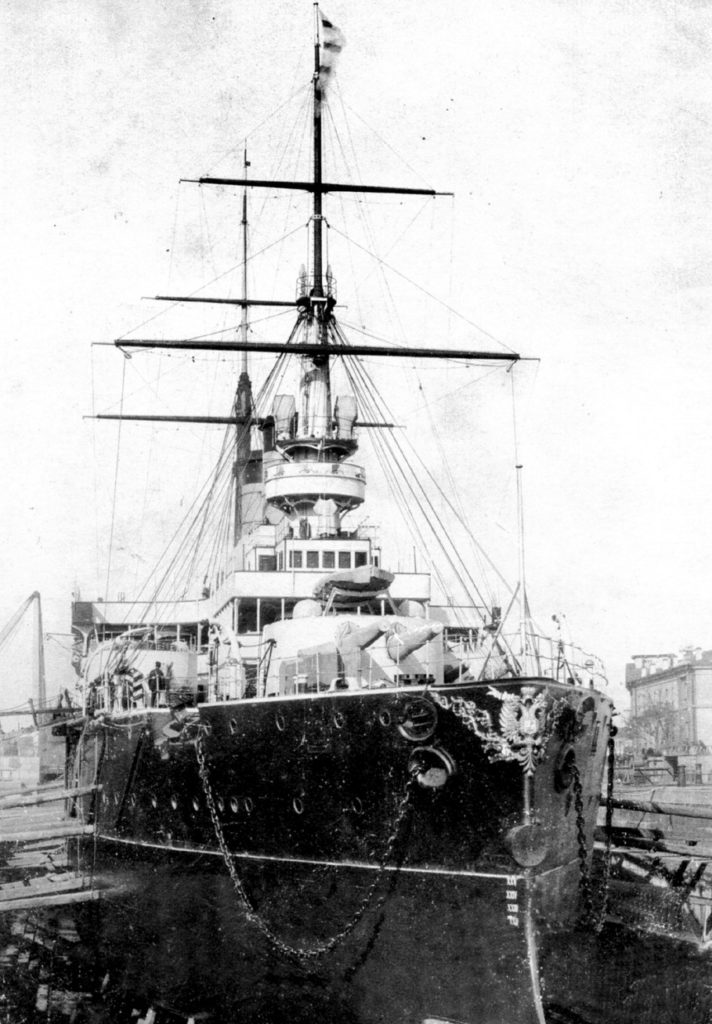
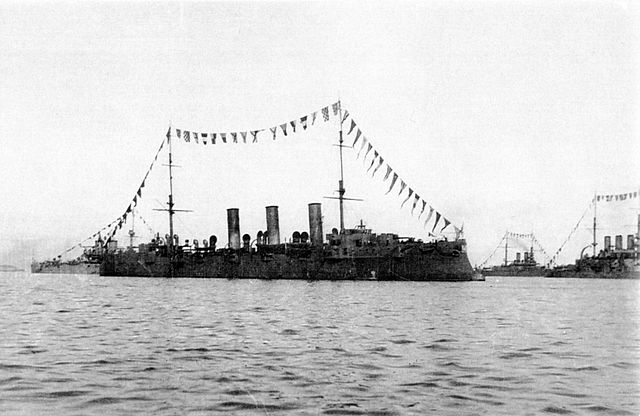
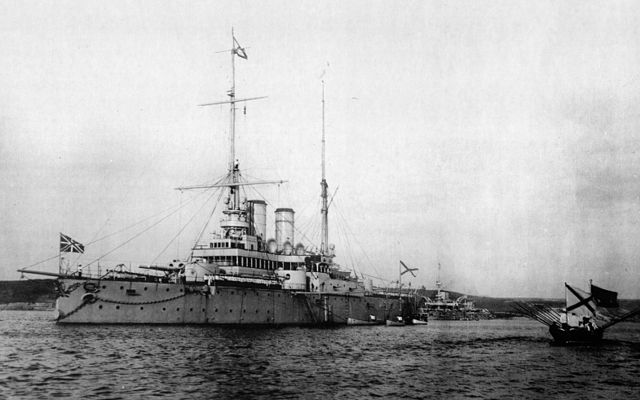
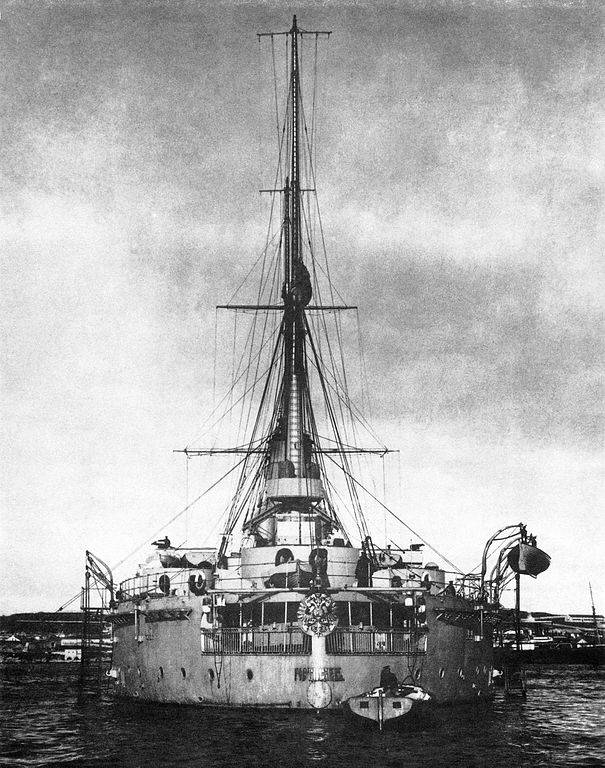
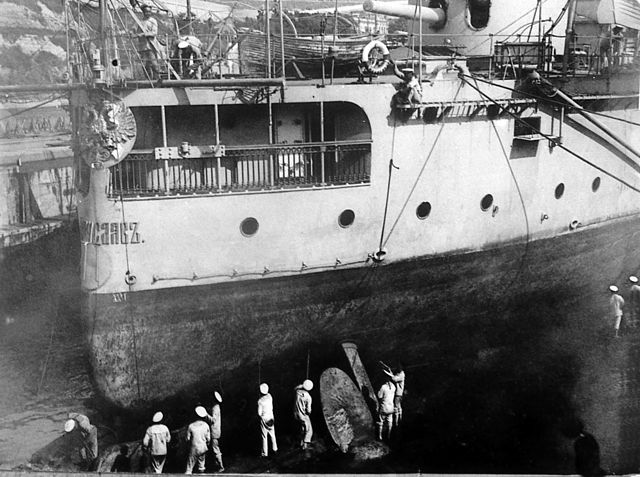
Read More/Src
Conway’s all the world’s fighting ships 1865-1921
Bascomb, Neal (2007). Red Mutiny: Eleven Fateful Days on the Battleship Potemkin. Boston: Houghton Mifflin.
Friedman, Norman (2011). Naval Weapons of World War One.
McLaughlin, Stephen (2003). Russian & Soviet Battleships.
Melnikov, R. M. (2006). 1893–1920 Squadron Battleship Rostislav
Silverstone, Paul H. (1984). Directory of the World’s Capital Ships.
Smigielski, Adam (1979). “Imperial Russian Navy Cruiser Varyag”.
Willmott, H. P. (2009). The Last Century of Sea Power: From Port Arthur to Chanak, 1894–1922.
Shirokorad, A. B. (1997). Korabelnaya artilleriya Rossiyskogo flota 1867–1922
//www.kchf.ru/ship/brone/rostislav.htm
//www.battleships.spb.ru/0393/Rostislav.html
//ship.bsu.by/ship/100114
//commons.wikimedia.org/wiki/Category:Rostislav_(ship,_1896) (photos)
http://www.dreadnoughtproject.org/models/ships/Rostislav/
Wikipedia page
Modellers’s corner: Combrig’s Rostislav WW1
Orel 1/200 paper model kit
Kombrig 1/700 Rostislav steelnavy review


 Latest Facebook Entry -
Latest Facebook Entry -  X(Tweeter) Naval Encyclopedia's deck archive
X(Tweeter) Naval Encyclopedia's deck archive Instagram (@navalencyc)
Instagram (@navalencyc)





 French Navy
French Navy Royal Navy
Royal Navy Russian Navy
Russian Navy Armada Espanola
Armada Espanola Austrian Navy
Austrian Navy K.u.K. Kriegsmarine
K.u.K. Kriegsmarine Dansk Marine
Dansk Marine Nautiko Hellenon
Nautiko Hellenon Koninklije Marine 1870
Koninklije Marine 1870 Marinha do Brasil
Marinha do Brasil Osmanlı Donanması
Osmanlı Donanması Marina Do Peru
Marina Do Peru Marinha do Portugal
Marinha do Portugal Regia Marina 1870
Regia Marina 1870 Nihhon Kaigun 1870
Nihhon Kaigun 1870 Preußische Marine 1870
Preußische Marine 1870 Russkiy Flot 1870
Russkiy Flot 1870 Svenska marinen
Svenska marinen Søværnet
Søværnet Union Navy
Union Navy Confederate Navy
Confederate Navy Armada de Argentina
Armada de Argentina Imperial Chinese Navy
Imperial Chinese Navy Marinha do Portugal
Marinha do Portugal Mexico
Mexico Kaiserliche Marine
Kaiserliche Marine 1898 US Navy
1898 US Navy Sovietskiy Flot
Sovietskiy Flot Royal Canadian Navy
Royal Canadian Navy Royal Australian Navy
Royal Australian Navy RNZN Fleet
RNZN Fleet Chinese Navy 1937
Chinese Navy 1937 Kriegsmarine
Kriegsmarine Chilean Navy
Chilean Navy Danish Navy
Danish Navy Finnish Navy
Finnish Navy Hellenic Navy
Hellenic Navy Polish Navy
Polish Navy Romanian Navy
Romanian Navy Turkish Navy
Turkish Navy Royal Yugoslav Navy
Royal Yugoslav Navy Royal Thai Navy
Royal Thai Navy Minor Navies
Minor Navies Albania
Albania Austria
Austria Belgium
Belgium Columbia
Columbia Costa Rica
Costa Rica Cuba
Cuba Czechoslovakia
Czechoslovakia Dominican Republic
Dominican Republic Haiti
Haiti Hungary
Hungary Honduras
Honduras Estonia
Estonia Iceland
Iceland Eire
Eire Equador
Equador Iran
Iran Iraq
Iraq Latvia
Latvia Liberia
Liberia Lithuania
Lithuania Mandchukuo
Mandchukuo Morocco
Morocco Nicaragua
Nicaragua Persia
Persia San Salvador
San Salvador Sarawak
Sarawak Uruguay
Uruguay Venezuela
Venezuela Zanzibar
Zanzibar Warsaw Pact Navies
Warsaw Pact Navies Bulgaria
Bulgaria Hungary
Hungary

 Bundesmarine
Bundesmarine Dutch Navy
Dutch Navy Hellenic Navy
Hellenic Navy Marina Militare
Marina Militare Yugoslav Navy
Yugoslav Navy Chinese Navy
Chinese Navy Indian Navy
Indian Navy Indonesian Navy
Indonesian Navy JMSDF
JMSDF North Korean Navy
North Korean Navy Pakistani Navy
Pakistani Navy Philippines Navy
Philippines Navy ROKN
ROKN Rep. of Singapore Navy
Rep. of Singapore Navy Taiwanese Navy
Taiwanese Navy IDF Navy
IDF Navy Saudi Navy
Saudi Navy Royal New Zealand Navy
Royal New Zealand Navy Egyptian Navy
Egyptian Navy South African Navy
South African Navy






























 Ukrainian Navy
Ukrainian Navy dbodesign
dbodesign